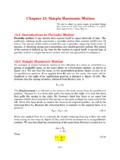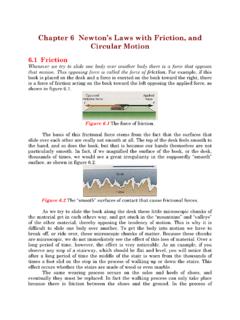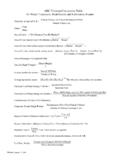Transcription of Chapter 16 Temperature and Heat - farmingdale.edu
1 Chapter 16 Temperature and Heat The determination of Temperature has long beenrecognized as a problem of the greatest importance inphysical science. It has accordingly been made asubject of most careful attention, and, especially inlate years, of very elaborate and refined experimentalresearches: and we are thus at present in possessionof as complete a practical solution of the problem ascan be desired, even for the most accurateinvestigation. William Thompson, Lord TemperatureThe simplest and most intuitive definition of Temperature is that Temperature is ameasure of the hotness or coldness of a body. That is, if a body is hot it has a hightemperature, if it is cold it has a low Temperature . This is not a very good definition,as we will see in a moment, but it is one that most people have a feel for, becausewe all know what hot and cold is.
2 Or do we?Let us reconsider the thought experiment treated in Chapter 1. We placethree beakers on the table, as shown in figure Several ice cubes are placed Figure A thought experiment on the first beaker of water, whereas boiling water is poured into the third place equal amounts of the ice water from beaker one and the boiling waterfrom beaker three into the second beaker to form a mixture. I now take my left handand plunge it into beaker one, and conclude that it is cold. After drying off my lefthand, I place it into the middle mixture. After coming from the ice water, themixture in the second beaker feels hot by comparison. So I conclude that themixture is now take my right hand and plunge it into the boiling water of beakerthree. (This is of course the reason why this is only a thought experiment. ) Iconclude that the water in beaker three is certainly hot.
3 Drying off my hand again I16-1then place it into beaker two. After the boiling water, the mixture feels cold bycomparison, so I conclude that the mixture is cold. After this relatively scientificexperiment, my conclusion is contradictory. That is, I found the middle mixture tobe either hot or cold depending on the sequence of the measurement. Thus, thehotness or coldness of a body is not a good concept to use to define the temperatureof a body. Although we may have an intuitive feel for hotness or coldness, we cannot use our intuition for any precise scientific ThermometerIn order to make a measurement of the Temperature of a body, a new technique,other than estimating hotness or coldness, must be found. Let us look for somecharacteristic of matter that changes as it is heated. The simplest suchcharacteristic is that most materials expand when they are heated.
4 Using thischaracteristic of matter we take a glass tube and fill it with a liquid, as shown infigure When the liquid is heated it expands and rises up the tube. The heightof the liquid in the tube can be used to measure the hotness or coldness of a device will become a A order to quantify the process, we need to place numerical values on theglass tube, thus assigning a number that can be associated with the hotness orcoldness of a body. This is the process of calibrating the , we place the thermometer into the mixture of ice and water of beaker 1in figure The liquid lowers to a certain height in the glass tube. We scratch amark on the glass at that height, and arbitrarily call it 0 degrees. Since it is thepoint where ice is melting in the water, we call 00 the melting point of ice. (Orsimilarly, the freezing point of water.)Then we place the glass tube into beaker three, which contains the boilingwater.
5 (We assume that heat is continuously applied to beaker three to keep theChapter 16 Temperature and Heat16-2water boiling.) The liquid in the glass tube is thus heated and expands to a newheight. We mark this new height on the glass tube and arbitrarily call it 1000. Sincethe water is boiling at this point, we call it the boiling point of the liquid in the tube expands linearly, to a first approximation, thedistance between 00 and 1000 can be divided into 100 equal parts. Any one of thesedivisions can be further divided into fractions of a degree. Thus, we obtain acomplete scale of temperatures ranging from 0 to 100 degrees. Then we place thisthermometer into the mixture of beaker two. The liquid in the glass rises to somenumber, and that number, whatever it may be, is the Temperature of the number is a numerical measure of the hotness or coldness of the body.
6 We callthis device a thermometer, and in particular this scale of Temperature that has 00for the melting point of ice and 1000 for the boiling point of water is called theCelsius Temperature scale and is shown in figure (a). This scale is namedafter the Swedish astronomer, Anders celsius , who proposed it in The Temperature , perhaps more familiar, Temperature scale is the Fahrenheittemperature scale shown in figure (b). The melting point of ice on this scale is32 0F and the boiling point of water is 212 0F. At first glance it might seem ratherstrange to pick 320 for the freezing point and 2120 for the boiling point of water. As amatter of fact Gabriel Fahrenheit, the German physicist, was not trying to use purewater as his calibration points. When the scale was first made, 0 0F corresponded tothe lowest Temperature then known, the Temperature of freezing brine (a salt watermixture), and 100 0F was meant to be the Temperature of the human proposed his scale in addition to the celsius and Fahrenheit scales there are other temperaturescales, the most important of which is the Kelvin or absolute scale, as shown infigure (c).
7 The melting point of ice on this scale is 273 K and the boiling point ofwater is 373 K. The Kelvin Temperature scale does not use the degree symbol fora Temperature . To use the terminology correctly, we should say that, zero degreesCelsius corresponds to a Temperature of 273 Kelvin. The Kelvin scale is extremelyChapter 16 Temperature and Heat16-3important in dealing with the behavior of gases. In fact, it was in the study of gasesthat Lord Kelvin first proposed the absolute scale in 1848. We will discuss this morenatural introduction to the Kelvin scale in the study of gases in Chapter 15. For thepresent, however, the implications of the Kelvin scale can still be appreciated bylooking at the molecular structure of a simplest picture of a solid, if it could be magnified trillions of times, is alarge array of atoms or molecules in what is called a lattice structure, as shown infigure Each dot in the figure represents an atom or molecule, depending on thenature of the substance.
8 Each molecule is in equilibrium with all the molecules Figure Simple lattice it. The molecule above exerts a force upward on the molecule, whereas themolecule below exerts a force downward. Similarly, there are balanced forces fromright and left and in and out. The molecule is therefore in equilibrium. In fact everymolecule of the solid is in equilibrium. When heat is applied to a solid body, theadded energy causes a molecule to vibrate around its equilibrium position. As anyone molecule vibrates, it interacts with its nearest neighbors causing them tovibrate, which in turn causes its nearest neighbors to vibrate, and so on. Hence, theheat energy applied to the solid shows up as vibrational energy of the molecules ofthe solid. The higher the Temperature of the solid, the larger is the vibrationalmotion of its molecules. The lower the Temperature , the smaller is the vibrationalmotion of its molecules.
9 Thus, the Temperature of a body is really a measure of themean or average kinetic energy of the vibrating molecules of the body. It is therefore conceivable that if you could lower and lower the temperatureof the body, the motion of the molecules would become less and less until at somevery low Temperature , the vibrational motion of the molecules would ceasealtogether. They would be frozen in one position. This point is called absolute zero,and is 0 on the Kelvin Temperature scale. From work in quantum mechanics,however, it is found that even at absolute zero, the molecules contain a certainamount of energy called the zero point though Temperature is really a measure of the mean kinetic energy ofthe molecules of a substance, from an experimental point of view it is difficult tomake a standard of Temperature in this way. Therefore, the International System ofChapter 16 Temperature and Heat16-4units considers Temperature to be a firth fundamental quantity and it is added tothe four fundamental quantities of length, mass, time, and electric charge.
10 The SIunit of Temperature is the kelvin, and is defined as 1 of the Temperature of thetriple point of water. The triple point of water is that point on apressure- Temperature diagram where the three phases of water, the solid, theliquid, and the gas, can coexist in equilibrium at the same pressure ConversionsThe celsius Temperature scale is the recognized Temperature scale in most scientificwork and in most countries of the world. The Fahrenheit scale will eventuallybecome obsolete along with the entire British engineering system of units. For thepresent, however, it is still necessary to convert from one Temperature scale toanother. That is, if a Temperature is given in degrees Fahrenheit, how can it beexpressed in degrees celsius , and vice versa? It is easy to see how this conversioncan be principle of the thermometer is based on the linear expansion of theliquid in the tube.















